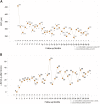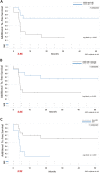Risk factors for repeated dexamethasone intravitreal implant therapy for macular edema due to treatment-naïve branch retinal vein occlusion
- PMID: 33743610
- PMCID: PMC7981849
- DOI: 10.1186/s12886-021-01904-8
Risk factors for repeated dexamethasone intravitreal implant therapy for macular edema due to treatment-naïve branch retinal vein occlusion
Abstract
Background: This study evaluated the effects of dexamethasone intravitreal implant on treatment-naïve branch retinal vein occlusion (BRVO)-induced macular edema (ME), and the risk factors for earlier repeated treatment.
Methods: Patients treated from 2013 to 2016 were enrolled. The patients' demographics, medical history, best-corrected visual acuity (BCVA), and central retinal thickness (CRT) were recorded. Risk factors for repeated treatment were identified using a Cox proportional hazard model and logistic regression.
Results: 29 patients (mean age: 58.64 ± 13.3 years) were included; 44.8% received only one injection, while 55.2% received two or more. The mean initial CRT was 457.8 ± 167.1 μm; the peak CRT and final CRT improved significantly to 248.9 ± 57.9 μm and 329.2 ± 115.1 μm, respectively. The peak BCVA improvement and final improvement were 29.5 ± 23.5 approximate ETDRS letters and 19.8 ± 24.4 letters, respectively, with 62.1% of patients improving by more than 15 letters. Older age, higher initial CRT, and diabetes were the risk factors for multiple injections.
Conclusion: Dexamethasone intravitreal implant results in significant peak CRT and BCVA improvements, while older age, higher initial CRT, and diabetes are risk factors for repeated injections. The optimal retreatment schedule for these patients should be further explored.
Keywords: Age; Branch retinal vein occlusion; Central retinal thickness; Dexamethasone intravitreal implant; Diabetes; Macular edema.
Conflict of interest statement
The authors have no conflicts of interest to declare.
Figures


Similar articles
-
The Effect of Age and Initial Central Retinal Thickness on Earlier Need of Repeat Ozurdex Treatment for Macular Edema Due to Retinal Vein Occlusion: A Retrospective Case Series.J Ocul Pharmacol Ther. 2017 Dec;33(10):763-772. doi: 10.1089/jop.2017.0070. Epub 2017 Sep 26. J Ocul Pharmacol Ther. 2017. PMID: 28949790
-
Safety and long-term efficacy of repeated dexamethasone intravitreal implants for the treatment of cystoid macular edema secondary to retinal vein occlusion with or without a switch to anti-VEGF agents: a 3-year experience.Graefes Arch Clin Exp Ophthalmol. 2018 Aug;256(8):1441-1448. doi: 10.1007/s00417-018-4016-7. Epub 2018 May 31. Graefes Arch Clin Exp Ophthalmol. 2018. PMID: 29855706
-
Two or more dexamethasone intravitreal implants in treatment-naïve patients with macular edema due to retinal vein occlusion: subgroup analysis of a retrospective chart review study.BMC Ophthalmol. 2015 Sep 4;15:118. doi: 10.1186/s12886-015-0106-z. BMC Ophthalmol. 2015. PMID: 26337664 Free PMC article.
-
Comparison between Ozurdex and intravitreal anti-vascular endothelial growth factor treatment for retinal vein occlusion-related macular edema: A systematic review and meta-analysis of randomized controlled trials.Indian J Ophthalmol. 2019 Nov;67(11):1800-1809. doi: 10.4103/ijo.IJO_382_19. Indian J Ophthalmol. 2019. PMID: 31638037 Free PMC article.
-
Resolution of Macular Edema secondary to rituximab after intravitreal dexamethasone: A case report and a review of the literature.Eur J Ophthalmol. 2024 Mar;34(2):NP52-NP55. doi: 10.1177/11206721231199120. Epub 2023 Aug 29. Eur J Ophthalmol. 2024. PMID: 37644808 Review.
Cited by
-
Characteristics of major and macular branch retinal vein occlusion.Sci Rep. 2022 Aug 18;12(1):14103. doi: 10.1038/s41598-022-18414-2. Sci Rep. 2022. PMID: 35982117 Free PMC article.
-
Long term efficacy and safety profile of dexamethasone intravitreal implant in retinal vein occlusions: a systematic review.Front Med (Lausanne). 2024 Nov 29;11:1454591. doi: 10.3389/fmed.2024.1454591. eCollection 2024. Front Med (Lausanne). 2024. PMID: 39678032 Free PMC article.
-
The Impact of Intraocular Treatment on Visual Acuity of Patients Diagnosed with Branch Retinal Vein Occlusions.Healthcare (Basel). 2023 May 12;11(10):1414. doi: 10.3390/healthcare11101414. Healthcare (Basel). 2023. PMID: 37239696 Free PMC article.
References
-
- Morley MG, Heier JS. Venous obstructive disease of the retina. In: Yanoff M, Duker JS, editors. Ophthalmology. 3. Missouri: Elsevier Mosby; 2009. pp. 597–605.
MeSH terms
Substances
LinkOut - more resources
Full Text Sources
Other Literature Sources
Research Materials

